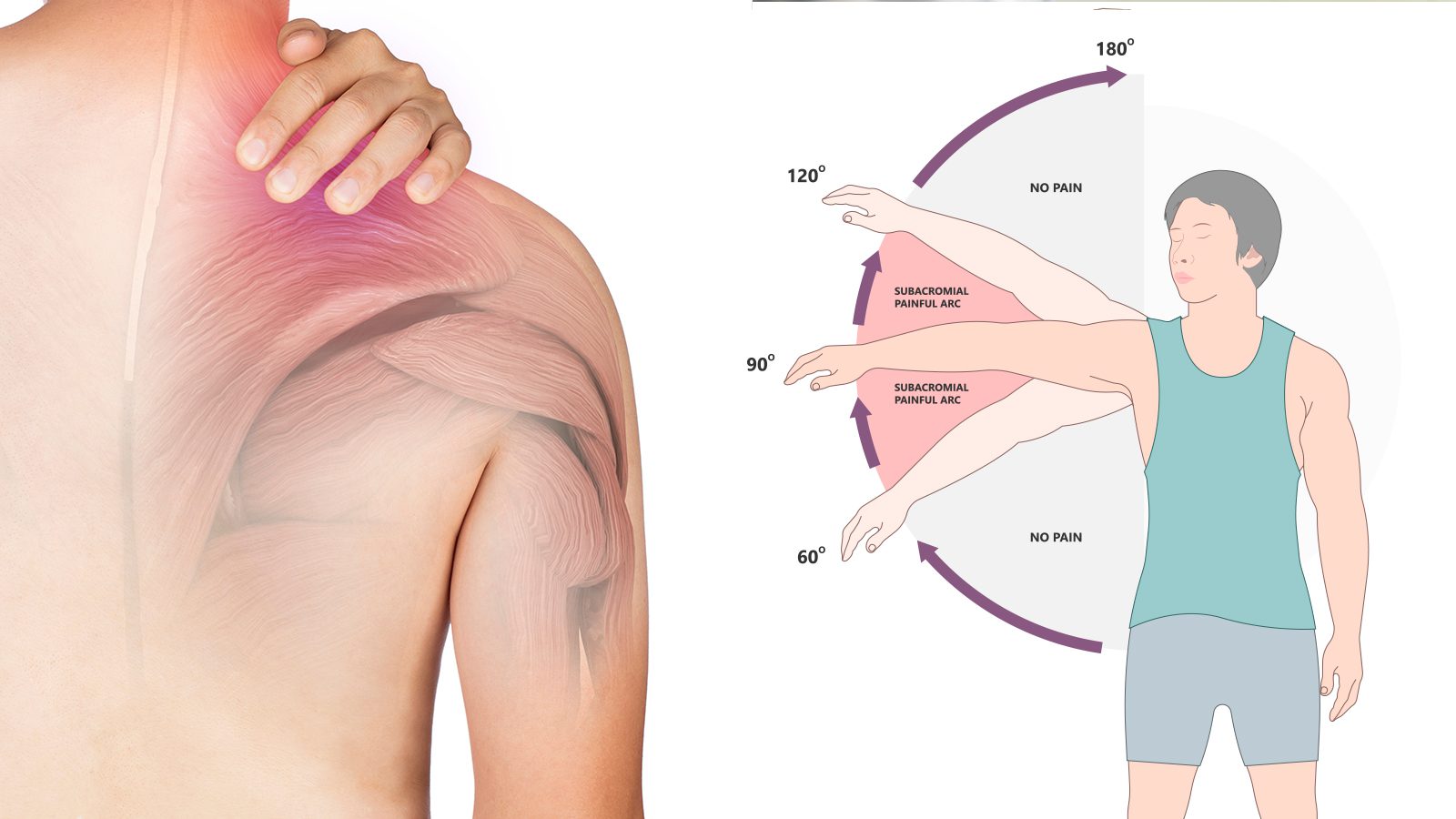Physical therapists provide insights into possible exercises and their benefits in addressing frozen shoulder, or adhesive capsulitis.
Frozen shoulder, or adhesive capsulitis, makes your shoulder feel stiff or painful. When you experience this condition, you’ll also likely have motion limitations. Exercise can help ease the issue and allow you relief.
Exercises for healing adhesive capsulitis involve relieving pain and restoring your range of motion. You’ll want to warm your shoulder before exercising by taking a warm shower or bath for about 15 minutes. Once you begin your exercise routine, push yourself until you feel tension but not pain in your shoulder.
Before starting a new exercise routine, it’s essential to understand frozen shoulder. Understanding what’s happening can help you choose the best exercises.
Understanding Frozen Shoulder
Adhesive capsulitis affects your shoulder joint because the connective tissue surrounding the joint thickens and tightens. When this happens, it causes shoulder stiffness, making it hard to move because it causes a limited range of motion. It also can cause discomfort or pain that hinders your ability to do your daily tasks.
If you experience pain from a frozen shoulder, it likely starts with minimal discomfort. However, it often worsens and impacts your life.
You might get this condition from an injury or surgery that limits mobilization for a while. Diabetes can also trigger frozen shoulder. People between 40 and 60 are more likely to experience it, and women have a higher risk than men.
The condition can last for years, but you can ease the symptoms gradually. Exercising is one of the best ways to begin healing, reduce pain, and improve range of motion.
Stretching Exercises for Adhesive Capsulitis
Shoulder stretches can help ease the discomfort of frozen shoulder and increase flexibility. Gentle stretching is essential because it can help increase mobility, reduce pain, and improve strength. It also helps you prepare for physical exertion and more intense exercise.
Some of the stretches you can try include the following:
Pendulum stretch
- Stand next to a surface you can place your hand flat on, like a table.
- Relax your shoulders, place one hand on the table or surface, and lean forward slightly.
- The arm that isn’t on the surface should hang down, and then you’ll swing it in a small circle.
- Keep swinging it in a circle about ten times in one direction, then reverse for another ten.
- Once you become comfortable, you can increase the size of your circle or hold a light handweight.
Cross-body stretch
You can sit or stand for this stretch, so choose whichever position you prefer.
- Start by placing your unaffected hand on the opposite elbow.
- Then, reach your affected arm across your body, gently lifting your elbow and stretching your shoulder.
- Hold the position for 20 to 30 seconds, release your arm, and repeat the stretch five times.
Strength-Building Exercises for Frozen Shoulder
Resistance training can improve joint functioning and help ease symptoms of frozen shoulder. Shoulder strengthening is beneficial because it can relieve pain, make daily tasks easier, and prevent further injury.
Some of the exercises you can do to build muscle strength include:
Abduction
- Stand sideways against a wall, keeping your arm straight beside you.
- Push your arm against the wall, and hold the position for about 10 seconds.
- Release your arm, rest, and repeat the exercise five to ten times.
Hands up
- Relax your shoulders and keep your arms at your sides.
- Bend your elbows to lift your arms.
- Rotate your shoulders, keeping your arms in the arm, until your palms face frontwards.
- Pull your shoulder blades together, hold them for a few seconds, and squeeze them together more.
Mobility Exercises
Shoulder mobility and movement exercises can ease the issues associated with a frozen shoulder. They help improve joint movement and allow you to return to your routine. Here are some ideas to try:
Pole exercises
- Find a long object you can hold in both hands, link a broom handle, or something similar.
- Hold the pole above your head and shift your affected shoulder so it’s out to the side as far as you can comfortably move it.
- Then, use your non-affected arm to put pressure on the pole and push your affected arm further.
- Hold the position for at least 10 seconds, and then try to push it further again.
Standing arm swings
- Stand straight with your arms loose at your sides.
- Swing your arms forward and raise them as possible, but don’t raise your shoulders.
- Lower your arms and raise them continually for 30 to 60 seconds.
- Throughout this exercise, keep your core engaged for the best results.
Balance Exercises for Frozen Shoulder
Balance training and stability exercises can ease frozen shoulder symptoms. It helps improve body balance for overall well-being. Here are some of the balance exercises you can try for frozen shoulder:
Forward bending shoulder exercise
- Stand in front of something that can support your weight when leaning forward.
- Bend your knees while keeping your feet shoulder-width apart.
- Lean forward, placing your unaffected hand on the object, and let your painful arm dangle.
- Swing your loose arm, going back and forth in each direction ten times.
Internal Rotation
- Lie on your back with your head on a small pillow or other soft object.
- Bend your knees so the souls of your feet are flat on the floor.
- Hold a light weight or another object on your affected side.
- Bend your elbow to a 90-degree angle, and rotate your arm toward your belly button.
- Rotate your arm back to the starting position and repeat the movement 10 times.
Yoga and Pilates for Frozen Shoulder
Yoga poses or pilates for shoulder health can help ease pain and improve mobility. They are also mind-body exercises that help you focus on specific areas of your body. Here are some of the yoga poses and pilates exercises you can try:
Kneeling shoulder shrug
- Kneel on the floor and extend your arms on the floor in front of you.
- Raise your shoulders toward your ears, and hold it for a few seconds.
- Relax your shoulders and lower them to the starting position.
- Repeat this movement for a few minutes.
Standing arm swings
- Stand with your feet hip-width apart and swing your arms back and forth.
- Repeat the movement several times while focusing on your shoulders.
High-to-low rows
- Hold a resistance band or light dumbbells in front, keeping your feet shoulder-width apart.
- Squeeze your shoulder blades together by pulling your elbows backward.
- Bring your elbows forward and return to the starting position.
- Repeat the movement for a few minutes.
Physiotherapy Exercises for Adhesive Capsulitis
Physiotherapy for frozen shoulder involves therapeutic exercises for rehabilitation during recovery. This exercise type is one of the most commonly recommended for adhesive capsulitis.
Here are some options that can help treat, recover from, and prevent frozen shoulder:
Finger walk
- Start by standing about two feet away from a wall and face it.
- Raise the affected arm to shoulder level and slightly bend your elbow.
- Touch the wall and walk your fingertips of the wall as far as you can.
- Slowly walk your fingers down to the starting position, and repeat it several times.
Passive supine forward elevation
- Lie comfortably on your back and place your painful arm at your side.
- Using your opposite arm, lift your affected arm, and hold it for about 20 seconds.
- Repeat the movement for a few minutes.
Aquatic Therapy
Aquatic therapy, or pool therapy, involves water-based exercises. These exercises help because the buoyancy of water provides many benefits, including:
- decreased pain
- improved range of motion
- increased strength
- better circulation
Lateral raise
- Position your body so your feet are shoulder-width apart and your arms are loose at your sides.
- Lift your arms until they’re shoulder height, and hold them for a few seconds. You’ll experience more resistance if you keep your arms below the water’s surface.
- Lower them back down, and repeat the movement for as long as possible.
Pass a ball behind your back
- Stand chest-deep in the water and keep your feet shoulder-width apart.
- Hold a ball in both hands and then pass it behind you from one have to the other.
- Bring the ball back to the front and repeat the exercise for a few minutes.
- Switch hands and do it again in the opposite direction.
Safe Exercise Practices
If you’re experiencing frozen shoulder, safe exercising is essential, and it’s sometimes best to seek professional guidance. Avoiding overexertion is necessary to prevent further injury. You should feel tension but not pain during each exercise.
Warm up and start slowly, gradually increasing the intensity or speed if you feel comfortable. Ease up if you notice pain so you don’t worsen your condition.
Discuss your situation with a healthcare professional before beginning a new exercise routine to ensure it’s safe for you. You may also consider a physical therapist who can guide you through the exercises to ensure you use the correct form.
Final Thoughts on Exercises to Heal Frozen Shoulder
Exercising can help manage and heal frozen shoulder, allowing you to feel better and perform your daily activities. Physical therapy for adhesive capsulitis helps ease pain and stiffness and increases your range of motion.
Be consistent with daily exercising, and target the affected shoulder or the best results. When you stick to your routine and ensure safe practices, you’ll reap the benefits of exercise in managing shoulder stiffness. Once you experience pain relief, continue exercises to prevent it from occurring again.


















